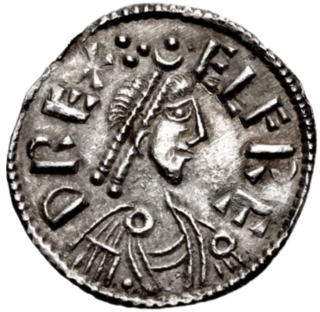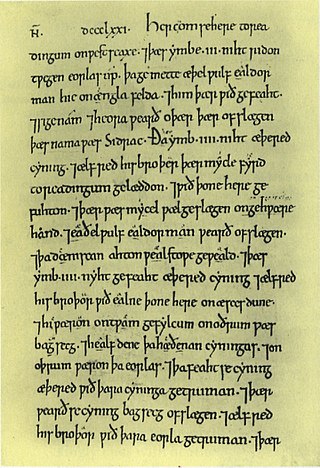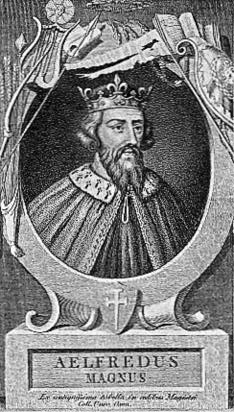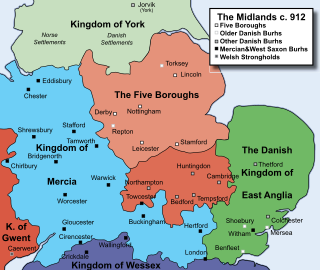Related Research Articles

Alfred the Great was King of the West Saxons from 871 to 886, and King of the Anglo-Saxons from 886 until his death in 899. He was the youngest son of King Æthelwulf and his first wife Osburh, who both died when Alfred was young. Three of Alfred's brothers, Æthelbald, Æthelberht and Æthelred, reigned in turn before him. Under Alfred's rule, considerable administrative and military reforms were introduced, prompting lasting change in England.

The Kingdom of the West Saxons, also known as the Kingdom of Wessex, was an Anglo-Saxon kingdom in the south of Great Britain, from around 519 until Alfred the Great declared himself as King of the Anglo-Saxons in 886.

Æthelflæd ruled as Lady of the Mercians in the English Midlands from 911 until her death in 918. She was the eldest child of Alfred the Great, king of the Anglo-Saxon kingdom of Wessex, and his wife Ealhswith.

The Danelaw was the part of England between the early tenth century and the Norman Conquest under Anglo-Saxon rule in which Danish laws applied. The Danelaw originated in the conquest and occupation of large parts of eastern and northern England by Danish Vikings in the late ninth century. The term applies to the areas in which English kings allowed the Danes to keep their own laws following the tenth-century English conquest in return for the Danish settlers' loyalty to the English crown. "Danelaw" is first recorded in the early 11th century as Dena lage.
Guthrum was King of East Anglia in the late 9th century. Originally a native of Denmark, he was one of the leaders of the "Great Summer Army" that arrived in Reading during April 871 to join forces with the Great Heathen Army, whose intentions were to conquer the kingdoms of Anglo-Saxon England. The combined armies were successful in conquering the kingdoms of East Anglia, Northumbria, and parts of Mercia, and overran Alfred the Great's Wessex, but were ultimately defeated by Alfred at the Battle of Edington in 878. The Danes retreated to their stronghold, where Alfred laid siege and eventually Guthrum surrendered.

At the Battle of Edington, an army of the kingdom of Wessex under Alfred the Great defeated the Great Heathen Army led by the Dane Guthrum sometime between 6 and 12 May 878, resulting in the Treaty of Wedmore later the same year. Primary sources locate the battle at "Eðandun". Until a scholarly consensus linked the battle site with the present-day village of Edington in Wiltshire, it was known as the Battle of Ethandun. This name continues to be used.

Æthelwold or Æthelwald was the younger of two known sons of Æthelred I, King of Wessex from 865 to 871. Æthelwold and his brother Æthelhelm were still infants when their father the king died while fighting a Danish Viking invasion. The throne passed to the king's younger brother Alfred the Great, who carried on the war against the Vikings and won a crucial victory at the Battle of Edington in 878.

The Battle of Englefield was a West Saxon victory against a Danish Viking army on about 31 December 870 at Englefield, near Reading in Berkshire. It was the first of a series of battles that took place following an invasion of Wessex by the Danish army in December 870.

Anglo-Saxon England or Early Medieval England covers the period from the end of Roman Britain in the 5th century until the Norman Conquest in 1066. It consisted of various Anglo-Saxon kingdoms until 927, when it was united as the Kingdom of England by King Æthelstan. It became part of the short-lived North Sea Empire of Cnut, a personal union between England, Denmark and Norway, in the 11th century.

The Battle of Reading was a victory for a Danish Viking army over a West Saxon force on about 4 January 871 at Reading in Berkshire. The Vikings were led by Bagsecg and Halfdan Ragnarsson and the West Saxons by King Æthelred and his brother, the future King Alfred the Great. It was the second of a series of battles that took place following an invasion of Wessex by the Danish army in December 870.

The Five Boroughs or The Five Boroughs of the Danelaw were the five main towns of Danish Mercia under the Danelaw. These were Derby, Leicester, Lincoln, Nottingham and Stamford. The first four later became county towns.

The Great Heathen Army, also known as the Viking Great Army, was a coalition of Scandinavian warriors who invaded England in 865 AD. Since the late 8th century, the Vikings had been engaging in raids on centres of wealth, such as monasteries. The Great Heathen Army was much larger and aimed to conquer and occupy the four kingdoms of East Anglia, Northumbria, Mercia and Wessex.
The Treaty of Alfred and Guthrum is a 9th-century peace agreement between Alfred of Wessex and Guthrum, the Viking ruler of East Anglia. It sets out the boundaries between Alfred and Guthrum's territories as well as agreements on peaceful trade, and the weregild value of its people.

The Burghal Hidage is an Anglo-Saxon document providing a list of over thirty fortified places (burhs), the majority being in the ancient Kingdom of Wessex, and the taxes assigned for their maintenance. The document, so named by Frederic William Maitland in 1897, survives in two versions of medieval and early modern date. Version A, Cotton Otho B.xi was badly damaged in a fire at Ashburnham House in 1731 but the body of the text survives in a transcript made by the antiquary Laurence Nowell in 1562. Version B survives as a composite part of seven further manuscripts, usually given the title De numero hydarum Anglie in Britannia. There are several discrepancies in the lists recorded in the two versions of the document: Version A includes references to Burpham, Wareham and Bridport but omits Shaftesbury and Barnstaple which are listed in Version B. Version B also names Worcester and Warwick in an appended list.

The Anglo-Saxon period of the history of London dates from the end of the Roman period in the 5th century to the beginning of the Norman period in 1066.

Edward the Elder was King of the Anglo-Saxons from 899 until his death in 924. He was the elder son of Alfred the Great and his wife Ealhswith. When Edward succeeded to the throne, he had to defeat a challenge from his cousin Æthelwold, who had a strong claim to the throne as the son of Alfred's elder brother and predecessor, Æthelred I.
Events from the 10th century in the Kingdom of England.

The Kingdom of the East Angles, informally known as the Kingdom of East Anglia, was a small independent kingdom of the Angles during the Anglo-Saxon period comprising what are now the English counties of Norfolk and Suffolk and perhaps the eastern part of the Fens, the area still known as East Anglia.
The Battle of the Holme took place in East Anglia on 13 December 902 where the Anglo-Saxon men of Wessex and Kent fought against the Danelaw and East Anglian Danes. Its location is unknown but may have been Holme in Huntingdonshire.
The Battle of Buttington was fought in 893 between a Viking army and an alliance of Anglo-Saxons and Welsh.
References
- ↑ The Anglo-Saxon Chronicles, ed. Michael Swanton, 2nd ed. (London 2000), pp. 101-2
52°10′14″N0°17′46″W / 52.1706°N 0.2962°W